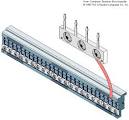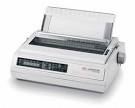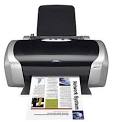 haracter matrix printers are a category of computer printers (typically impact printers) that place characters from a fixed character set anywhere onto a fixed grid of possible locations on the page. Examples of these are daisy wheel printers, golf ball printers, chain printers, and band printers. A character printer prints one character at a time.
haracter matrix printers are a category of computer printers (typically impact printers) that place characters from a fixed character set anywhere onto a fixed grid of possible locations on the page. Examples of these are daisy wheel printers, golf ball printers, chain printers, and band printers. A character printer prints one character at a time.
 ine printers, as the name implies, print an entire line of text at a time. Three principal designs existed. In drum printers, a drum carries the entire character set of the printer repeated in each column that is to be printed. In chain printers, the character set is arranged multiple times around a chain that travels horizontally past the print line. In either case, to print a line, precisely timed hammers strike against the back of the paper at the exact moment that the correct character to be printed is passing in front of the paper. The paper presses forward against a ribbon which then presses against the character form and the impression of the character form is printed onto the paper.
ine printers, as the name implies, print an entire line of text at a time. Three principal designs existed. In drum printers, a drum carries the entire character set of the printer repeated in each column that is to be printed. In chain printers, the character set is arranged multiple times around a chain that travels horizontally past the print line. In either case, to print a line, precisely timed hammers strike against the back of the paper at the exact moment that the correct character to be printed is passing in front of the paper. The paper presses forward against a ribbon which then presses against the character form and the impression of the character form is printed onto the paper.
 page printer is a type of computer printer that prints on cut sheet paper. A modern page printer may use any of various technologies, such as laser, LED or inkjet. Most modern computer printers are page printers. The page printer was jointly developed (circa 1900) and patented in 1924 by Sterling Morton and Howard Krum.
page printer is a type of computer printer that prints on cut sheet paper. A modern page printer may use any of various technologies, such as laser, LED or inkjet. Most modern computer printers are page printers. The page printer was jointly developed (circa 1900) and patented in 1924 by Sterling Morton and Howard Krum.
 dot matrix printer or impact matrix printer is a type of computer printer with a print head that runs back and forth, or in an up and down motion, on the page and prints by impact, striking an ink-soaked cloth ribbon against the paper, much like a typewriter. Unlike a typewriter or daisy wheel printer, letters are drawn out of a dot matrix, and thus, varied fonts and arbitrary graphics can be produced. Because the printing involves mechanical pressure, these printers can create carbon copies and carbonless copies.
dot matrix printer or impact matrix printer is a type of computer printer with a print head that runs back and forth, or in an up and down motion, on the page and prints by impact, striking an ink-soaked cloth ribbon against the paper, much like a typewriter. Unlike a typewriter or daisy wheel printer, letters are drawn out of a dot matrix, and thus, varied fonts and arbitrary graphics can be produced. Because the printing involves mechanical pressure, these printers can create carbon copies and carbonless copies.
letter-quality printer was a form of computer impact printer that was able to print with the quality typically expected from a business typewriter such as an IBM Electric.
A letter-quality printer operates in much the same fashion as a typewriter. An array of letters, numbers, or symbols embossed on a metal surface, are used to strike a ribbon of ink, depositing the ink on the page and thus printing a character.
Letter-quality printers, however, were slow, noisy, and incapable of printing graphics or images, generally limited to monochrome, and limited to a fixed set (usually one) of typefaces, though certain font effects like underlining and boldface could be achieved by over striking.
n computing, inkjet printers are a type of computer printer that operates by propelling variably-sized droplets of liquid or molten material (ink) onto a page. They are the most common type of printer for the general consumer due to their low cost, high quality of output, capability of printing in different colors, and ease of use.
 The inkjet was built on the progress made by many earlier versions. Among many contributors, Epson, Hewlett-Packard and Canon can claim a substantial share of the credit for the development of the modern inkjet. In the worldwide consumer market, four manufacturers account for the majority of inkjet printer sales: Canon, Hewlett-Packard, Epson, and Lexmark.
The inkjet was built on the progress made by many earlier versions. Among many contributors, Epson, Hewlett-Packard and Canon can claim a substantial share of the credit for the development of the modern inkjet. In the worldwide consumer market, four manufacturers account for the majority of inkjet printer sales: Canon, Hewlett-Packard, Epson, and Lexmark.
 olid ink is a technology used in computer printers and multifunction devices originally created by Tektronix in 1986. After Xerox acquired the Tektronix Color Printing and Imaging Division in 2000, the solid ink technology became part of the Xerox line of office printing and imaging products. Early offerings focused on the graphic arts industry. The Phaser III product introduced in 1991 cost $10,000 US. As the technology improved and costs were reduced, the focus shifted to office printing environments where quality and cost efficiency are important.
olid ink is a technology used in computer printers and multifunction devices originally created by Tektronix in 1986. After Xerox acquired the Tektronix Color Printing and Imaging Division in 2000, the solid ink technology became part of the Xerox line of office printing and imaging products. Early offerings focused on the graphic arts industry. The Phaser III product introduced in 1991 cost $10,000 US. As the technology improved and costs were reduced, the focus shifted to office printing environments where quality and cost efficiency are important.Current solid ink products are the Xerox Phaser 8560 and 8860 color printers and the Xerox Phaser 8560MFP and 8860MFP color multifunction printers.
 laser printer is a common type of computer printer that rapidly produces high quality text and graphics on plain paper. As with digital photocopiers and multifunction printers (MFPs), laser printers employ a xerographic printing process but differ from analog photocopiers in that the image is produced by the direct scanning of a laser beam across the printer's photoreceptor.
laser printer is a common type of computer printer that rapidly produces high quality text and graphics on plain paper. As with digital photocopiers and multifunction printers (MFPs), laser printers employ a xerographic printing process but differ from analog photocopiers in that the image is produced by the direct scanning of a laser beam across the printer's photoreceptor.
 dye-sublimation printer is a computer printer which employs a printing process that uses heat to transfer dye onto a medium such as a plastic card, paper, or fabric. The sublimation name is applied because the dye transitions between the solid and gas states without going through a liquid stage. Many consumer and professional dye-sublimation printers are designed and used for producing photographic prints.
dye-sublimation printer is a computer printer which employs a printing process that uses heat to transfer dye onto a medium such as a plastic card, paper, or fabric. The sublimation name is applied because the dye transitions between the solid and gas states without going through a liquid stage. Many consumer and professional dye-sublimation printers are designed and used for producing photographic prints.
 haracter matrix printers are a category of computer printers (typically impact printers) that place characters from a fixed character set anywhere onto a fixed grid of possible locations on the page. Examples of these are daisy wheel printers, golf ball printers, chain printers, and band printers. A character printer prints one character at a time.
haracter matrix printers are a category of computer printers (typically impact printers) that place characters from a fixed character set anywhere onto a fixed grid of possible locations on the page. Examples of these are daisy wheel printers, golf ball printers, chain printers, and band printers. A character printer prints one character at a time.





The services are helpful in many ways. carbonless, carbonless forms
ReplyDeleteComputer + Chemistry: Types Of Printer >>>>> Download Now
Delete>>>>> Download Full
Computer + Chemistry: Types Of Printer >>>>> Download LINK
>>>>> Download Now
Computer + Chemistry: Types Of Printer >>>>> Download Full
>>>>> Download LINK LH
Computer + Chemistry: Types Of Printer >>>>> Download Now
ReplyDelete>>>>> Download Full
Computer + Chemistry: Types Of Printer >>>>> Download LINK
>>>>> Download Now
Computer + Chemistry: Types Of Printer >>>>> Download Full
>>>>> Download LINK